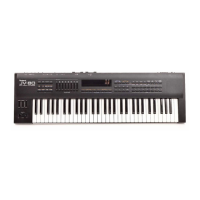7.0peration Examples of the
JV-80
You can change the degree to which individual
Parts respond to your playing strength
by adjusting the
parameters
related to velocity
(P.66). In this example, by keeping
the level of the strings sound low, the
dynamic range
of the
piano sound can be heard
more easily.
[5]
Press
I
INT
TRANS
I
and select the Int.Velo Sense page
by using
[a].
Set the value
for Part 1 to 1
0,
and Part 2 to 32.
PEERF-ORM
trUTORIRL
IIS
#+101+32
I
4-321
"
Int.Uelc
+
3211+32
I +32
14
Select the Int.V-Crv
page and set Part 1 to curve
2
and
Part 2 to curve 4.
PERFORM tlUTGRlRL
s
Xnt . U~C:^^.' F'2:::::2,.-.--"
1 ;!.
6 # 2 1
4\ :u II :l I i i i
i i
Select the
Int.Max Velocity page and set
Part 1 to a value of 64 and Part 2
to 127.
PERFORM
I 1
6
T
IJ
T" R 1 H I....
S
I l-i t
„ II
-B X
1.
..I
& 1 O
C- i t.
::;!
64 I :l, 27 I 1 27 I 1 27 1 1 27 [ J. 27
I 1 27 I 1 27
The relative volume
range of the two Parts and how they
respond to velocity as determined
by
these
parameters is
shown in the
graphs below. The range over which the
Patch changes is narrow for Part
1
and wide
for Part 2.
Part 1
Part 2
64
127
The
range over which the sounding
Part changes
By using the above
operations on all eight
Parts, setting each Part to respond differently depending
on
how
and in
which
range you
play
the
keyboard, you can achieve
a
variety
of
dynamic
and textural changes as you play.
191

